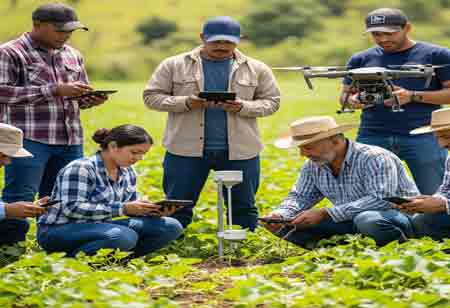Thank you for Subscribing to Agri Business Review Weekly Brief
Bridging the Tech Gap in Rural Agriculture in Latin America
Latin America’s smallholder farmers face a "tech gap" that limits their productivity. Bridging this gap through digital agriculture is essential for enhancing food security and sustainable development.

By
Agri Business Review | Thursday, September 04, 2025
Stay ahead of the industry with exclusive feature stories on the top companies, expert insights and the latest news delivered straight to your inbox. Subscribe today.
Fremont, CA: Latin America is a global powerhouse in agricultural production, featuring vast arable land, abundant water resources, and diverse climates. Smallholder farmers, despite being the backbone of the region's food supply and employing over half of the rural labor force, often remain excluded from the transformative potential of modern agricultural technologies. This exclusion creates a significant "tech gap," hindering productivity, perpetuating poverty, and undermining food security. Bridging this divide is not merely an economic imperative but a social and environmental one, promising a more resilient and sustainable agricultural future for the region.
The Landscape of Latin American Smallholder Farming
Smallholder farmers in Latin America face numerous challenges, including limited digital literacy, financial constraints, inadequate infrastructure, limited access to service providers, market barriers, information gaps, and vulnerability to climate change. However, the role of digital agriculture in revolutionizing smallholder farming is significant, as it enhances productivity and efficiency, provides real-time insights into crop health, soil quality, and water needs, and automates irrigation systems. Equally important are digital advisory services, which can provide reassurance by offering real-time weather forecasts, agronomic tips, and best practices tailored to specific crops and regions. AI and big data analytics can process vast datasets to deliver actionable predictions, enabling preventive actions and informed decisions. Financial inclusion and market access can be achieved through agri-digital financial services (DFS), e-commerce and digital procurement platforms, as well as climate resilience technologies that monitor climate conditions, predict extreme weather, and advise on climate-smart practices.
Bridging the Gap: Strategies and Initiatives
Integrating smallholders into the digital agricultural landscape requires a multi-pronged approach involving governments, NGOs, the private sector, and farmers themselves. Infrastructure development and connectivity, including expanding rural broadband, providing affordable devices, and increasing access to energy sources, are essential for enhancing internet connectivity in remote areas. Digital literacy and capacity-building programs, tailored training, community-based learning, and youth engagement are also necessary. Inclusive technology design and business models, as well as co-creation with farmers, and diverse capital sources, are also crucial. National digital agriculture policies, which provide a regulatory framework and incentives for the adoption of digital technologies in agriculture, are also essential. Collaborative ecosystems, such as public-private partnerships, knowledge sharing platforms, and investor engagement, are also crucial for successful integration. Encouraging investment in AgriFoodTech startups catering to smallholder farmers is vital, as large-scale farmers are often the primary targets, highlighting the need for a more inclusive investment focus.
Bridging the tech gap in rural agriculture in Latin America is a complex but achievable goal. It demands a holistic approach that goes beyond simply providing technology. It requires addressing foundational issues of infrastructure, digital literacy, financial inclusion, and market access. By fostering collaborative ecosystems, co-designing farmer-centric solutions, and implementing supportive policies, Latin America can unlock the full potential of its smallholder farmers, ensuring greater food security, economic resilience, and sustainable development for generations to come.





